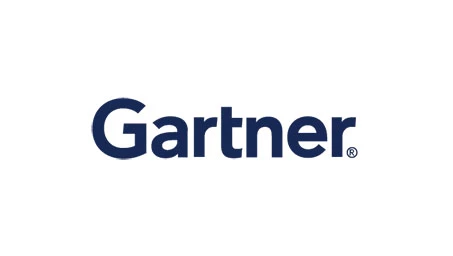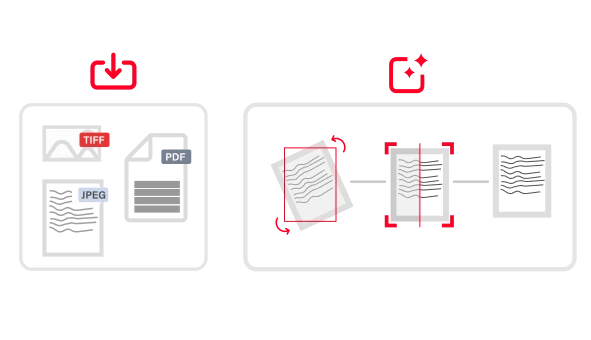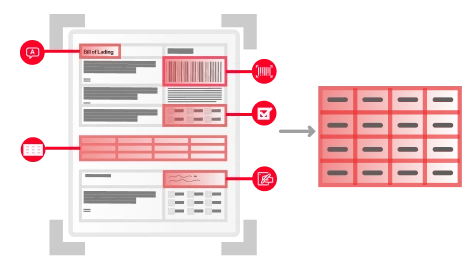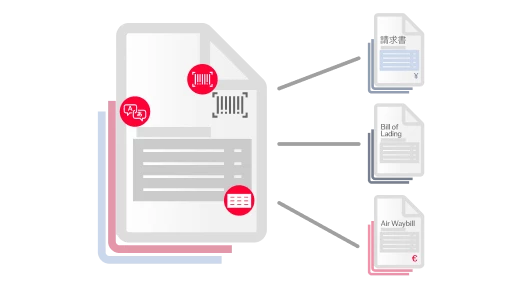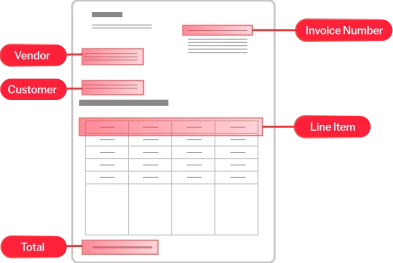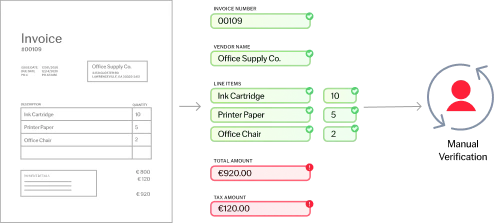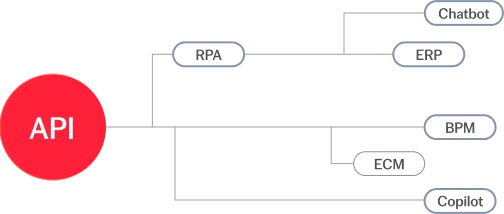
Data extraction and validation
Precise, reliable data extraction to power
decision-making


Unlock business-critical
data—quickly and accurately
Data extraction is the core element within the intelligent document processing (IDP) pipeline. Powered by advanced AI and machine learning, our IDP platform effortlessly handles any document type, language, or complexity—automating data capture and driving efficiency.
With pre-trained models, low-code customization, and continuous learning, ABBYY enables faster, more accurate processing, reducing manual tasks and improving your business operations from day one.
Instant access to the data that fuels your processes
Any document, any language, any complexity
ABBYY’s purpose-built AI handles structured (e.g., tax forms), semi-structured (e.g., invoices), and unstructured (e.g., agreements) documents in over 200 languages. It efficiently extracts business-critical data from multi-page documents and complex tables, ensuring smooth, automated workflows for your business.
Over 150 pre-trained extraction models
Kickstart your automation with over 150 pre-built models—also known as document skills— designed for various document types and industries. These models detect and extract key data and apply built-in validation rules, ensuring consistency and accuracy out of the box. Easily deploy the models from the ABBYY Marketplace for immediate results. Then, watch your process continue to improve as the models learn from your organization’s unique document variations.
Low-code design and training of custom models
Our low-code platform puts the power of AI into the hands of business users. For unique or specialized document types, you can easily design and train custom extraction models with just a few examples—no coding expertise required. As more documents and new variations are processed, your models will learn and adapt, continuously refining their performance and accuracy.
Rapid model design with auto-labeling (preview)
One of the most time-consuming tasks in training AI models is manually labeling documents. ABBYY eliminates this bottleneck with its advanced auto-labeling, powered by ABBYY’s very own purpose-built multimodal model Phoenix 1.0 and zero-shot learning. With the very first document, the system automatically identifies key data fields and suggests the relevant information to extract, while allowing you to make adjustments with ease. This dramatically accelerates the design and deployment of new extraction models.
High straight-through processing from day one
With models pre-trained on thousands of documents, ABBYY achieves over 90% straight-through processing (STP) right out of the gate. This means your organization benefits from fast, touchless processing that significantly reduces manual intervention, slashing operational costs and improving turnaround times.
Continuous learning
Real-world documents are messy and unpredictable, but ABBYY’s purpose-built AI gets smarter with each new variation. Through continuous learning and human-in-the-loop (HITL) feedback, your models adapt to evolving document types and formats, constantly improving extraction accuracy and efficiency. This ensures your automation remains robust and effective over time.
Advanced handwritten data extraction
ABBYY IDP revolutionizes handwritten text recognition, surpassing the limitations of legacy intelligent character recognition (ICR) tools that struggle with accuracy. Using cutting-edge AI-based technology, ABBY IDP accurately recognizes and extracts handwritten data—including cursive writing—from documents such as invoices, receipts, medical forms, applications, transportation documents, and more. This helps you achieve new levels of automation, even for the most complex and traditionally challenging document types.
Comprehensive data normalization and validation
Our pre-trained models feature advanced data normalization and validation rules, automatically performing cross-checks, sum checks, vendor matching, purchase order validation, and more. This ensures that your extracted data is accurate and reliable, flagging discrepancies for further manual review if necessary. You can customize these rules to fit your specific business or process needs, further enhancing the reliability of your document workflows.
Tame LLM results with ABBYY IDP to automate smarter
While large language models (LLMs) offer exciting new possibilities, they aren’t without their challenges. For businesses looking to incorporate the power of LLMs into their operations without the risk of AI hallucinations or unreliable results, ABBYY IDP provides a dependable solution. As a gateway, ABBYY IDP seamlessly connects your automation workflows to generative AI and general-purpose LLMs, letting you automate complex processes beyond simple data extraction while still having peace of mind about the accuracy of your results. Plus, automatically generated, purpose-built prompts ensure rapid implementation, improved precision, and faster return on investment.

Deepen your understanding of data extraction
Checklist
5 Steps to Successful Intelligent Document Processing
Discover the power of IDP to make your automation robots smarter and your data extraction more efficient.

Article
Pushing the Boundaries of Intelligent Document Processing
Learn how advanced AI models are enhancing the accuracy, speed, and versatility of document-centric tasks.

Whitepaper
The Inevitable Need for Understanding Content
Low-code/no-code tools are helping businesses improve data extraction, making it simpler to automate processes and speed up digital transformation.

Checklist
5 Steps to Successful Intelligent Document Processing
Discover the power of IDP to make your automation robots smarter and your data extraction more efficient.

Article
Pushing the Boundaries of Intelligent Document Processing
Learn how advanced AI models are enhancing the accuracy, speed, and versatility of document-centric tasks.

Whitepaper
The Inevitable Need for Understanding Content
Low-code/no-code tools are helping businesses improve data extraction, making it simpler to automate processes and speed up digital transformation.

How data extraction works
Data extraction is the key that unlocks the true value of your documents. After document intake brings your information into the system, and document classification sorts it, it’s time to find and pull the critical details you need through data extraction.
This is where intelligent document processing (IDP) truly shines, picking out the precise details you need from each document. Whether it's invoice numbers, customer names, or key contract terms, data extraction turns raw information from your documents into organized, usable data, ready to fuel your automation and decision-making processes.
- Pull the important data
- Verify and validate
- Organize and structure
Pull the important data
Extracting the right data from documents requires a highly optimized for this task combination of technologies. Depending on the document type, language, and content, the process may involve tools like OCR and ICR and underlying AI models and algorithms such as object detection, advanced word recognition, key-value pair extraction, and natural language processing (NLP). These technologies work together to turn images or scanned documents into readable text, understand the context, and pull out the specific data you need.
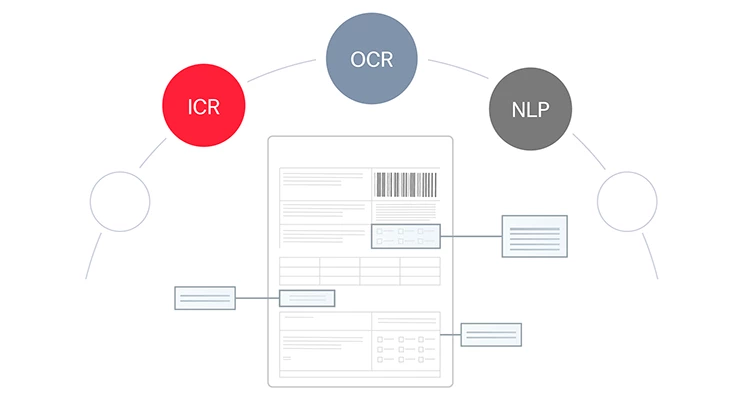
Verify and validate
The extracted data undergoes a rigorous quality check to ensure it is accurate and complete. This involves comparing it against predefined criteria—specific rules that you have set up ahead of time—and external databases for further validation. In more intricate scenarios, a human-in-the-loop review process is employed, where experts step in to provide their judgment and ensure the highest level of accuracy.
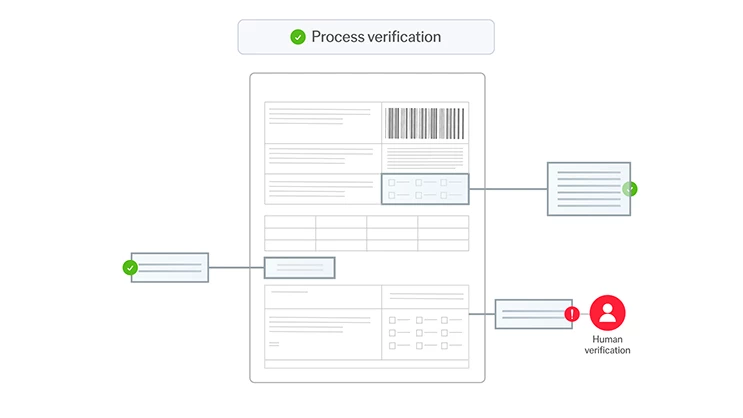
Organize and structure
The extracted and verified data is then presented into a structured format, such as CSV or JSON. This makes the data easier to store, analyze, and export to downstream applications to fuel business processes.
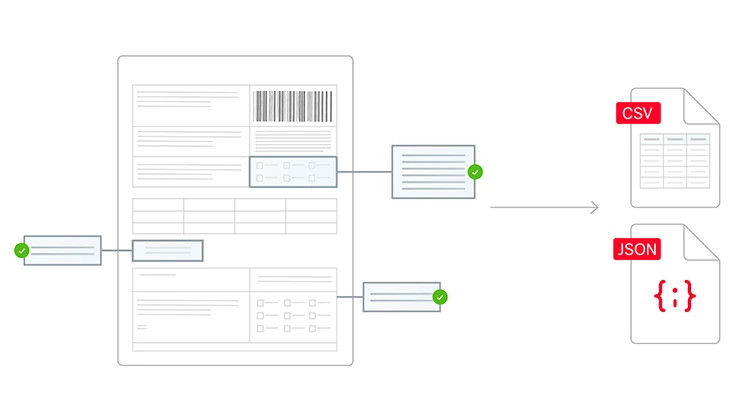
Intelligent document processing pipeline
Learn more about IDP and OCR
Blog
OCR vs. IDP: What’s the Difference?
Discover how IDP goes beyond OCR to revolutionize business workflows with AI and machine learning.

Blog
AI Is Not Just for OCR
Insurers can unlock true automation potential by integrating AI throughout the entire process for scalability and accuracy.
Podcast
AI-Powered Document Processing Is Changing Accounts Payable—Here's How
Learn how AI, machine learning, IDP, and OCR work together to automate your invoice processing.
Blog
OCR vs. IDP: What’s the Difference?
Discover how IDP goes beyond OCR to revolutionize business workflows with AI and machine learning.

Blog
AI Is Not Just for OCR
Insurers can unlock true automation potential by integrating AI throughout the entire process for scalability and accuracy.
Podcast
AI-Powered Document Processing Is Changing Accounts Payable—Here's How
Learn how AI, machine learning, IDP, and OCR work together to automate your invoice processing.
Data extraction—Frequently asked questions (FAQs)
What is data extraction, and why is it important?
What types of data can be extracted from documents?
Can I integrate the extracted data with my existing systems?
Yes, so long as your data extraction platform is set up for integration. The best IDP solutions provide APIs or ready connectors, allowing data to flow seamlessly into platforms for business process management (BPM), enterprise content management (ECM), enterprise resource planning (ERP), robotic process automation (RPA), and more.
Integration lets you put your extracted data to use immediately. For example, invoice information that has been pulled can be seamlessly entered into your accounting system, no manual data entry required. This way, more of your workflows are automated for efficiency.
How accurate is the data extraction process? Is the information validated for accuracy and completeness?
Advanced data extraction platforms achieve accuracy rates of up to 99.5%. They let you define custom rules and validation checks to ensure extracted data adheres to the criteria and requirements of your choosing. Plus, you can further cross-check and verify extracted information against other databases or systems.
For critical processes or complex documents, human experts can step in to double-check and refine the AI’s work. This human-in-the-loop (HITL) review process also helps the system learn and improve over time.
Request a demo today!
Schedule a demo and see how ABBYY intelligent automation can transform the way you work—forever.


